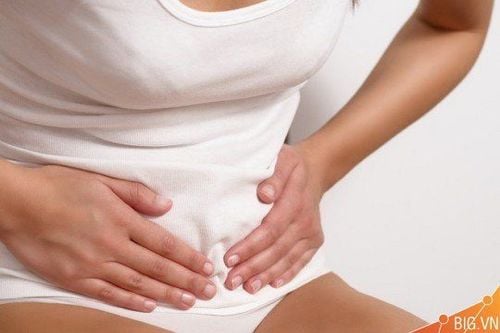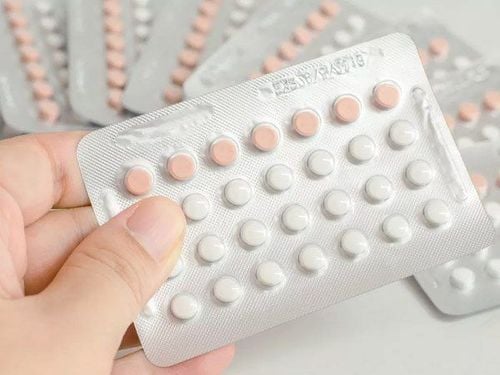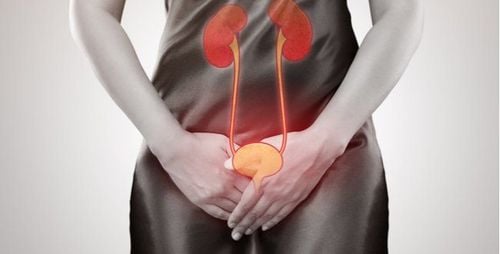This is an automatically translated article.
The article was professionally consulted by Specialist Doctor I Le Thi Phuong - Department of Obstetrics and Gynecology - Vinmec Ha Long International General Hospital. Dr. Le Thi Phuong has 29 years of experience in the field of obstetrics and gynecology.After giving birth, a woman's body will secrete a lot of fluid, this is a normal physiological phenomenon, but it can also cause abnormal changes and adversely affect the recovery process of the mother's health. , in which the most dangerous condition is still lower abdominal pain after birth due to fluid stasis.
1. What is postpartum fluid obstruction?
Postpartum discharge is actually the membrane of the placenta, the lining of the cervix, and the fluid from the vagina that sheds, creating favorable conditions for the growth of genital bacteria. Normally, a woman's body after giving birth will have certain changes, the uterus will perform the task of contraction to expel fluid out, which can be the cause of moderate postpartum abdominal pain. or intense. In case the fluid cannot drain out and stagnates in the uterus, it will cause postnatal stasis. If a pregnant woman has a stasis of postpartum fluid, if not detected and intervened in time, it will lead to dangerous complications such as blood clotting disorder, unstoppable bleeding, excessive blood loss, dangerous to her health and life. network.Trắc nghiệm: Những điều cần biết về kiêng cữ sau sinh
Sau sinh, cơ thể sản phụ sẽ có rất nhiều sự thay đổi, việc thực hiện tốt các kiêng cữ sau sinh và bổ sung đầy đủ các chất dinh dưỡng cho cơ thể sẽ giúp ích rất nhiều trong quá trình hồi phục sức khỏe. Bài trắc nghiệm dưới đây sẽ giúp mọi người có cái nhìn tổng quan về kiêng cữ sau sinh và thực hiện sao cho phù hợp nhất.The following content is prepared under supervision of Thạc sĩ, Bác sĩ y khoa, Tạ Quốc Bản , Sản phụ khoa , Khoa Sản phụ khoa - Bệnh viện Đa khoa Quốc tế Vinmec Phú Quốc
2. What causes postnatal stasis?

2.1 Due to inactivity There are many mothers after giving birth because they are too tired, exhausted or worried that walking can affect them. affected the health recovery process, so I lay still and refused to move. However, it is the lack of exercise that causes the body to have fluid retention and abdominal pain after cesarean section. Usually, the first 10 days after giving birth will be the best time for the uterus to contract and elastic to expel the fluid, so doctors always recommend that women after giving birth should only lie in bed. within the first 24 hours after giving birth, then you should sit up and practice walking to help the uterus contract, to speed up the process of expelling the fluid and shorten the postpartum period.
2.2 Because the cervix is closed Closed cervix will make it impossible for the fluid to escape, this is common in women who have a caesarean section and are indicated for caesarean section when the stage of spontaneous labor has not yet been reached. Naturally, causing the cervix to not open (although during surgery the doctors have dilated the cervix), the fluid cannot escape, which will cause a blockage of the fluid in the uterus and cause the product to fall. women with abdominal pain after cesarean section.
3. Differentiate postpartum lower abdominal pain and abdominal pain due to fluid stasis
Postpartum lower abdominal pain and abdominal pain due to fluid stasis are two completely different phenomena, it is necessary to distinguish clearly in order to have the right treatment. In fact, there are many women who experience abdominal pain after cesarean or vaginal delivery, this may be a normal manifestation when the uterus contracts to push the fluid out or changes to allow the body to adapt. suspect after the baby is born. However, if the abdominal pain is accompanied by unusual symptoms such as high fever, non-stop pain, the mother needs to go to the hospital for examination because it may be a sign of postpartum fluid stasis.Normally, postpartum women have about 20 to 30 days for the discharge to be expelled, however, if you have lower abdominal pain 3 months after giving birth, it is an abnormal sign and the mother must think about it. Right up to the case of postpartum fluid stasis, it is necessary to determine what the pain is like, how does it manifest?
In case the postpartum abdominal pain is accompanied by the following abnormal symptoms, the pregnant woman may have been stuck in the production for too long, it is necessary to go to the hospital for examination immediately, the symptoms include:
Mild fever Feeling of tightness and pain in the lower abdomen Vagina with little discharge and bad odor When touching the abdomen, it feels hard and has lumps. Cervical examination shows it is closed, when using the hand to check the cervix I see the discharge is dark black with a bad smell Feeling a lot of pain when pressing the cervix
4. How to prevent stagnation of postpartum fluid?

In addition, early breastfeeding, direct breastfeeding is also a way to help the uterus contract well and prevent postnatal stasis effectively. For a mother whose uterus is in an anterior flexion position, being able to lie down on her stomach for about 30 minutes a day will make it easier for the discharge to be pushed out.
To reduce postpartum pain symptoms and give birth smoothly and safely, pregnant women need to understand:
How the labor process takes place, how long it usually takes to have a normal delivery or cesarean section, to best protect the health of the unborn baby. Methods to relieve pain during childbirth, limit pain and relieve psychological pressure during labor. The way to push and breathe during childbirth is usually the right way so that the labor takes place quickly, the pregnant woman does not lose strength during childbirth. How to control postpartum uterine contractions in the shortest time. How to take care of the perineal suture does not cause infection and dangerous complications. Early postpartum re-examination to detect dangerous abnormalities such as residual placenta, missing gauze. Take care of newborn until full month healthy. The biggest obsession of women who have a caesarean section is the pain after giving birth because the anesthetic has worn off. Every movement, even the smallest, makes the incision painful. Understanding the process of carrying a painful labor and wishing to relieve the pain of childbirth, Vinmec offers a comprehensive Maternity program with a complete "painless delivery" service during and after delivery using technology. non-morphine epidural analgesia and pudendal nerve anaesthesia. During the birth process, the mother will be guided by the midwives on how to push and breathe properly, the baby will be born in just 10-15 minutes. After birth, the baby will be cared for in a sterile room before being returned to the mother.
Pregnant women will rest in a high-class hospital room, designed according to international hotel standards, 1 mother 1 room with full facilities and modern equipment. Mothers will be consulted by nutritionists on how to feed the baby before being discharged from the hospital. Postpartum follow-up with both mother and baby with leading Obstetricians and Pediatricians.
Please dial HOTLINE for more information or register for an appointment HERE. Download MyVinmec app to make appointments faster and to manage your bookings easily.















